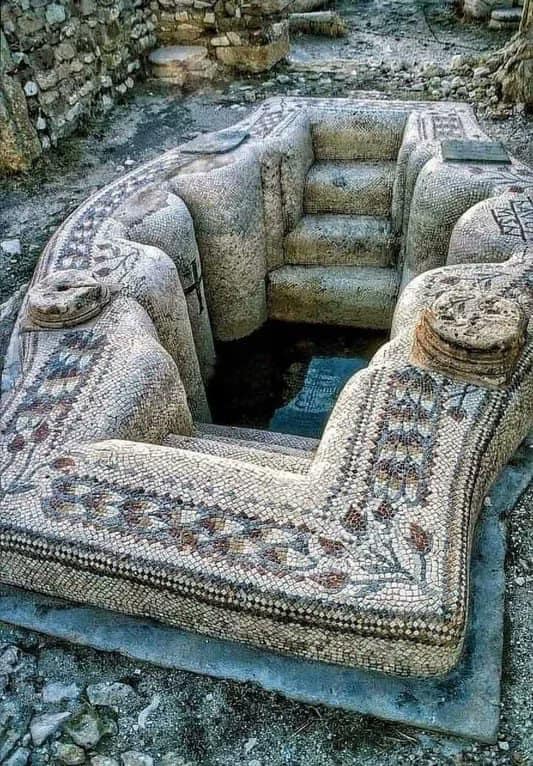In 2021, a significant archaeological discovery in Sbeitla, Tunisia, brought to light a 1,500-year-old Byzantine bathtub. This remarkable find offers a captivating glimpse into the opulent lifestyle and sophisticated culture of the Byzantine Empire, particularly as it extended its influence into North Africa. The discovery serves as a valuable link to the architectural and societal advancements of a bygone era.
Sbeitla’s Historical Importance
Known historically as Sofitola, Sbeitla was far more than a typical provincial city in the Byzantine Empire. Nestled in what is now central Tunisia, this strategic hub played a pivotal role in disseminating Byzantine culture and influence throughout North Africa. The city was a beacon of prosperity, as evidenced by its well-preserved ruins, which include an array of grand public buildings and religious monuments. These structures rival the grandeur of those found in Constantinople, the empire’s capital, and underscore the city’s importance in the broader Byzantine world.

The Luxurious Byzantine Bathtub
A Symbol of Wealth and Sophistication
The stone bathtub discovered in Sbeitla is much more than a utilitarian object—it is a powerful symbol of wealth, sophistication, and the refined lifestyle of Byzantine society. Carved from a single block of stone, the bathtub is adorned with intricate designs that reflect the exceptional craftsmanship of the era. This piece exemplifies how even in a provincial city, the luxuries associated with the Byzantine elite were accessible, illustrating the far-reaching influence of the empire’s culture and architectural standards.
Masterful Craftsmanship
The creation of this bathtub highlights the extraordinary skills of Byzantine artisans. Transforming raw stone into a functional yet aesthetically striking object required an advanced understanding of both technical and artistic principles. The precise detailing and robust construction of the bathtub demonstrate the meticulous attention to quality that was characteristic of Byzantine craftsmanship. These attributes not only ensured the artifact’s durability over centuries but also celebrated the empire’s commitment to blending beauty with utility.
Cultural and Social Context
More Than a Bathing Facility
In Byzantine society, bathhouses were more than places to cleanse the body—they were integral to the social fabric. Bathhouses served as hubs of cultural exchange, fostering community interactions and providing spaces where ideas and traditions were shared. The discovery of the Sbeitla bathtub sheds light on the role such spaces played in daily life. This single artifact reveals how important communal bathing rituals were in strengthening social ties and maintaining the cohesion of Byzantine communities.
Evidence of a Thriving Culture in North Africa
The presence of a sophisticated artifact like this bathtub in a city like Sbeitla underscores the extensive reach of Byzantine influence. It demonstrates that even provincial areas enjoyed the same high standards of living and architectural expertise as the empire’s core urban centers. This discovery highlights how the cultural and artistic achievements of the Byzantines transcended geographic boundaries, cementing their legacy as a civilization that valued progress, innovation, and inclusivity.
Broader Implications and Modern Relevance
A Window into the Past
This extraordinary discovery provides an unparalleled opportunity to delve deeper into the lives of people who lived in the Byzantine period. Each detail of the bathtub tells a story—not just about the object itself, but about the people who used it, the artisans who crafted it, and the society that valued such intricate creations. By studying artifacts like this, researchers gain insights into the everyday lives, values, and aspirations of Byzantine individuals.
Influencing Contemporary Design
The principles of Byzantine architecture and craftsmanship continue to inspire modern designers and architects. The harmonious balance between functionality and beauty, as seen in the Sbeitla bathtub, remains a guiding principle in contemporary design. This connection between ancient and modern traditions underscores the enduring relevance of Byzantine innovations, offering lessons in creating designs that stand the test of time.
Preserving a Legacy
The discovery of this Byzantine bathtub is not just a testament to the ingenuity of the past; it also emphasizes the importance of preserving historical artifacts for future generations. Such finds enrich our collective understanding of human history and provide valuable educational opportunities. By protecting these treasures, we honor the achievements of ancient civilizations and ensure that their stories continue to inspire and inform us.
A Testament to Byzantine Influence
Ultimately, the Sbeitla bathtub is more than an artifact—it is a symbol of the Byzantine Empire’s enduring impact on global culture and heritage. It highlights the sophistication of an empire that seamlessly combined artistry, architecture, and social organization to create a lasting legacy. The influence of Byzantine civilization extended far beyond its borders, shaping societies and traditions across vast regions.
As archaeologists continue to uncover relics like this, they reaffirm the importance of understanding and preserving our shared history. Each discovery provides another piece of the puzzle, helping us build a richer, more complete picture of the past. The Sbeitla bathtub is not just a window into Byzantine provincial life—it is a reminder of the timeless connection between humanity’s past and present.
This exceptional find invites us to reflect on the intricate tapestry of history, where even the most utilitarian objects can reveal profound stories of innovation, resilience, and cultural exchange. By studying and appreciating these remnants of history, we gain a deeper appreciation for the complexities of ancient societies and their enduring contributions to our world today.





